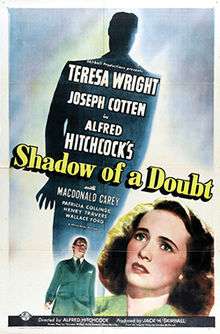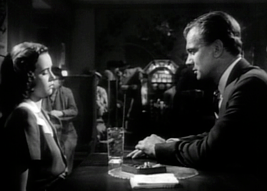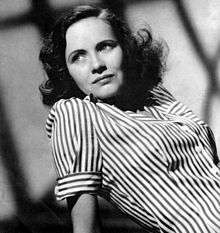Shadow of a Doubt
| Shadow of a Doubt | |
|---|---|
 Theatrical release poster | |
| Directed by | Alfred Hitchcock |
| Produced by | Jack H. Skirball |
| Screenplay by | |
| Story by | Gordon McDonell |
| Starring | |
| Music by |
Dimitri Tiomkin (original) Franz Lehár |
| Cinematography | Joseph A. Valentine |
| Edited by | Milton Carruth |
Production company |
Skirball Productions |
| Distributed by | Universal Pictures |
Release date |
|
Running time | 108 minutes[1] |
| Country | United States |
| Language | English |
| Box office | $1.2 million (US rentals)[2] |
Shadow of a Doubt is a 1943 American psychological thriller film noir directed by Alfred Hitchcock, and starring Teresa Wright and Joseph Cotten. Written by Thornton Wilder, Sally Benson, and Alma Reville, the film was nominated for an Academy Award for Best Story for Gordon McDonell. In 1991, the film was selected for preservation in the United States National Film Registry by the Library of Congress, being deemed "culturally, historically, or aesthetically significant".
Plot

Charlie Newton is a bored teenaged girl living in the idyllic town of Santa Rosa, California. She receives wonderful news: Her mother's younger brother (her namesake), Charles Oakley, is arriving for a visit. Two men appear, supposedly working on a national survey. One takes a photo of Uncle Charlie, who demands the roll of film, because "no one takes my photograph." The younger surveyor, Jack Graham, asks young Charlie out, and she guesses that he is really a detective. He explains that her uncle is one of two suspects who may be the "Merry Widow Murderer". Charlie refuses to believe it at first, but then observes Uncle Charlie acting strangely, primarily with a certain news clipping from her father's newspaper. The initials engraved inside a ring he gave her match those of one of the murdered women, and during a family dinner he reveals his hatred of rich widows.
One night, when Charlie's father and his friend Herbie discuss how to commit the perfect murder, Uncle Charlie lets his guard down and describes elderly widows as "fat, wheezing animals"; he then says, "What happens to animals when they get too fat and too old?" Horrified, Charlie runs out. Uncle Charlie follows and takes her into a seedy bar. He admits he is one of the two suspects. He begs her for help; she reluctantly agrees not to say anything, as long as he leaves soon, to avoid a horrible confrontation that would destroy her mother, who idolizes her younger brother. Detective Saunders tells Charlie that the photo they took of Uncle Charlie was sent for identification by witnesses. News breaks that an alternative suspect was chased by police and killed by an airplane propeller; it is assumed that he was the murderer. Jack tells young Charlie that he loves her and would like to marry her, and leaves.
Uncle Charlie is delighted to be exonerated, but young Charlie knows all his secrets. Soon, she falls down dangerously steep stairs which were cut through. Uncle Charlie says he wants to settle down, and young Charlie says she will kill him if he stays. Later that night, she is trapped in the garage with a car spewing exhaust fumes, and almost dies.
Uncle Charlie announces he is leaving for San Francisco, along with a rich widow, Mrs. Potter. Young Charlie boards the train with her younger sister Ann and their brother to see Uncle Charlie's compartment. As the children disembark, Uncle Charlie restrains his niece Charlie on the train, hoping to kill her by shoving her out after it picks up speed. However, in the ensuing struggle, he falls in front of an oncoming train. At his funeral, Uncle Charlie is honored by the townspeople. Jack has returned, and Charlie confesses that she withheld crucial information. They resolve to keep Uncle Charlie's crimes a secret.
Cast

- Teresa Wright as Charlotte "Charlie" Newton, a precocious teenager who initially idolizes her loving uncle.
- Joseph Cotten as Charles "Uncle Charlie" Oakley
- Macdonald Carey as Detective Jack Graham
- Henry Travers as Joseph Newton, Young Charlie's father, who loves to read crime stories.
- Patricia Collinge as Emma Newton, Young Charlie's mother and Uncle Charlie's sister.
- Wallace Ford as Detective Fred Saunders
- Hume Cronyn as Herbie Hawkins, a neighbor and crime fiction buff. He discusses ideas for the perfect murder with Charlie's father
- Edna May Wonacott as Ann Newton
- Charles Bates as Roger Newton
- Irving Bacon as Station Master
- Clarence Muse as Pullman Porter
- Janet Shaw as Louise
- Estelle Jewell as Catherine
Hitchcock's cameo
Alfred Hitchcock appears about 16 minutes into the film, on the train to Santa Rosa, playing bridge with a man and a woman (Dr. and Mrs. Harry). Charlie is traveling on the train under the assumed name of Otis. Mrs. Harry (Sarah Edwards) is eager to help Otis, who is feigning illness in order to avoid meeting fellow passengers, but Dr. Harry (Edward Fielding) is not interested and keeps playing bridge. Dr Harry replies to Hitchcock that he doesn't look well while Hitchcock is holding a full suit of spades, the best hand for bridge.

Production
The project began when the head of David Selznick's story department, Margaret McDonell, told Hitchcock that her husband Gordon had an interesting idea for a novel that she thought would make a good movie. His idea, called "Uncle Charlie," was based on the true story of Earle Leonard Nelson, a mass murderer of the 1920s known as "the Gorilla Man".
Shadow of a Doubt was both filmed and set in Santa Rosa, California, which was portrayed as a paragon of a supposedly peaceful, small, pre-War American city. Since Thornton Wilder wrote the original script, the story is set in a small American town, a popular setting of Wilder's, but with an added Hitchcock touch to it. In Patrick McGilligan's biography of Hitchcock, he said the film was perhaps the most American film that Hitchcock had made up to that time.
The opening scenes take place in the Central Ward of Newark, New Jersey. The city skyline and landmarks such as the Pulaski Skyway are featured in the opening shot. The location shots were used to circumvent the wartime War Production Board restrictions of a maximum cost of $5000 for set construction.[3]
The Newton family home is located at 904 McDonald Avenue in Santa Rosa, which is still standing. The stone railway station in the film was built in 1904 for the Northwestern Pacific Railroad and is one of the few commercial buildings in central Santa Rosa to survive the earthquake of April 18, 1906. The station is currently a visitor center. Some of the buildings in the center of Santa Rosa that are seen in the film were damaged or destroyed by earthquakes in 1969; much of the area was cleared of debris and largely rebuilt. The library was a Carnegie Library which was demolished in the mid-1960s due to seismic concerns.
The film was scored by Dimitri Tiomkin, his first collaboration with Hitchcock (the others being Strangers on a Train, I Confess and Dial M for Murder). In his score, Tiomkin quotes the famous Merry Widow Waltz of Franz Lehár, often in somewhat distorted forms, as a leitmotif for Uncle Charlie and his serial murders. During the opening credits, the waltz theme is heard along with a prolonged shot of couples dancing.
Reception
Upon release, the film received unanimously positive reviews. Bosley Crowther, critic for The New York Times, loved the film, stating that "Hitchcock could raise more goose pimples to the square inch of a customer's flesh than any other director in Hollywood".[4] Time Magazine called the film "superb"[4], while Variety stated that "Hitchcock deftly etches his small-town characters and homey surroundings".[4] The entertainment trade paper The Film Daily was yet another reviewer in 1943 that praised every aspect of the production. The publication predicted big “box office” for theaters presenting Hitchcock’s latest work, although in its detailed review of Shadow of a Doubt the paper does mistakenly refer to the director’s 1941 film Suspicion as "'Suspense'":
Of all the startling feature films directed by Alfred Hitchcock—superman of suspense and wizard of mystery—this one is geared most highly to thrill American audiences and to pour coin into the coffers of U.S. theaters....There are no red herrings yanked across the trail in this attraction, as was the case in his recent hit, "Suspense". The story moves inflexibly toward an ending which the onlooker more or less clearly expects, but which elicits the periodic hope that the worst fears of Teresa Wright will not be realized.
...Production values under Jack H. Skirball are first-rate, as is Joseph Valentine’s photography. There isn’t a shadow of a doubt about this picture’s success.[5]
In a 1964 interview on Telescope with host Fletcher Markle, Markle noted, "Mr Hitchcock, most critics have always considered Shadow of a Doubt, which you made in 1943, as your finest film." Hitchcock replied immediately, "Me too." Markle then asked, "That is your opinion of it still?" Hitchcock replied, "Oh, no question." At the time, Hitchcock's most recent work was Marnie. When later interviewed by François Truffaut, Hitchcock denied the suggestion that Shadow of a Doubt was his "favourite".[6] But in the audio interview with Truffaut, Hitchcock confirmed it was his favourite film, and later reiterated that Shadow of a Doubt was his favorite film in his interview with Mike Douglas in 1969 and in his interview with Dick Cavett in 1972. Alfred Hitchcock's daughter Pat Hitchcock also said that her father's favorite film was Shadow of a Doubt in Laurent Bouzereau’s 2000 documentary Beyond Doubt: The Making of Hitchcock's Favorite Film.
Today, the film is still regarded as a major work of Hitchcock. Contemporary critic Dave Kehr called it Hitchcock's "first indisputable masterpiece."[7] Many other critics have agreed. Based on 35 reviews on the website Rotten Tomatoes, the film has received 100%, with a consensus of "Alfred Hitchcock's earliest classic — and his own personal favorite — deals its flesh-crawling thrills as deftly as its finely shaded characters".[4] When asked by critics as to an overarching theme for the film Hitchcock responded: "Love and good order is no defense against evil". In his book Bambi vs. Godzilla, David Mamet calls it Hitchcock's finest film. [8]
Adaptations and remakes
Radio
The film was adapted for Cecil B. DeMille's Lux Radio Theater aired on January 3, 1944 with its original leading actress Teresa Wright and William Powell as Uncle Charlie (Patrick McGilligan said Hitchcock had originally wanted Powell to play Uncle Charlie, but MGM refused to lend the actor for the film.). In 1950, Shadow of a Doubt was featured as a radio-play on Screen Directors Playhouse. It starred Cary Grant as Uncle Charlie and Betsy Drake as the young Charlie.[9] It was also adapted to the Ford Theater (February 18, 1949). The Screen Guild Theater adapted the film twice with Joseph Cotten, the first with Vanessa Brown as young Charlie, and the second with Deanna Durbin in the role. The Academy Award Theater production of Shadow of a Doubt was aired on September 11, 1946.[10]
Film
The film has been remade twice: in 1958 as Step Down to Terror, and again (under the original title) as a 1991 TV movie in which Mark Harmon portrayed Uncle Charlie.
Shadow of a Doubt served as the inspiration for Park Chan-wook's 2013 film Stoker.
See also
- List of films with a 100% rating on Rotten Tomatoes, a film review aggregator website
References
- ↑ "SHADOW OF A DOUBT (A)". British Board of Film Classification. February 10, 1943. Retrieved December 1, 2014.
- ↑ "Top Grossers of the Season", Variety, 5 January 1944 p 54
- ↑ "$5,000 Production". Life. 1943-01-25. pp. 70–78.
- 1 2 3 4 "Shadow of a Doubt". Rotten Tomatoes. Retrieved September 30, 2013.
- ↑ "Reviews Of New Films", Shadow of a Doubt; The Film Daily (New York, N.Y.), January 8, 1943, page 5, columns 3-4. Internet Archive, San Francisco, California. Retrieved August 27, 2018.
- ↑ Jim McDevitt, Eric San Juan. A Year of Hitchcock: 52 Weeks With the Master of Suspense. ISBN 9780810863880. Page 158.
- ↑ "Shadow of a Doubt". Chicago Reader. Retrieved April 19, 2016.
- ↑ David Mamet, Bambi vs. Godzilla (Vintage, 2008).
- ↑ "Other Cary Grant Radio Appearances". carygrantradio.com.
- ↑ "Old Time Radio (OTR) Drama and Adventure".
External links
| Wikiquote has quotations related to: Shadow of a Doubt |
| Wikimedia Commons has media related to Shadow of a Doubt (film). |
- Shadow of a Doubt at the American Film Institute Catalog
- Shadow of a Doubt on IMDb
- Shadow of a Doubt at the TCM Movie Database
- Shadow of a Doubt at Rotten Tomatoes
- Streaming audio
- Shadow of a Doubt on Screen Guild Theater: May 24, 1943
- Shadow of a Doubt on Lux Radio Theater: January 3, 1944